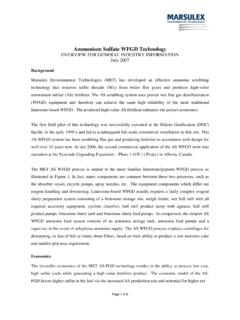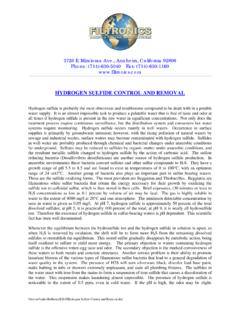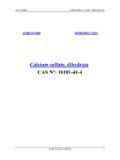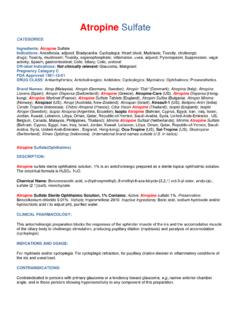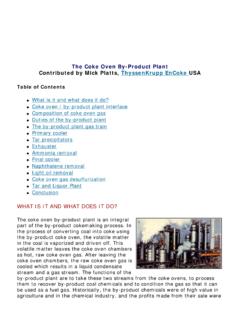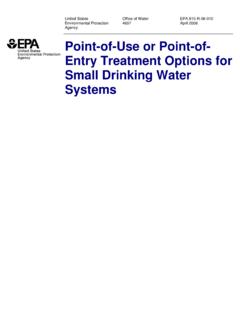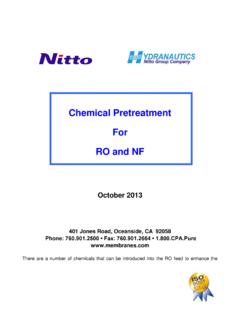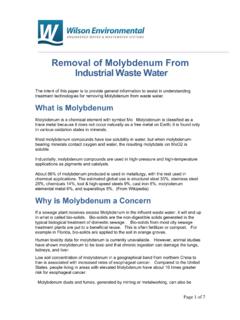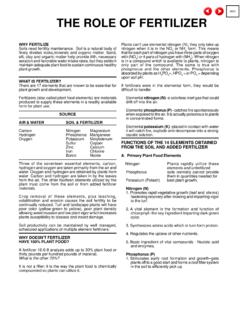Transcription of VINCRISTINE SULFATE INJECTION - Medsafe
1 Data Sheet New Zealand Version 1 DBL VINCRISTINE SULFATE INJECTION Name VINCRISTINE SULFATE . Description VINCRISTINE SULFATE is the salt of an alkaloid obtained from the periwinkle plant (Cantharanthus roseus). VINCRISTINE SULFATE occurs as a white or slightly yellow, hygroscopic, amorphous or crystalline powder and is freely soluble in water and slightly soluble in alcohol. DBL VINCRISTINE SULFATE INJECTION : A sterile solution of VINCRISTINE SULFATE 1 milligram/mL and mannitol 100 milligrams/mL in Water for Injections. The solution does not contain any preservative. Pharmacology The precise mechanism of action of VINCRISTINE SULFATE remains under investigation. It appears to bind to or crystallise critical microtubular proteins of the mitotic spindle, thus preventing their proper polymerisation and causing metaphase arrest. The antineoplastic effects of the vinca alkaloids are related to their ability to bind specifically with the intracellular protein tubulin, a key component of cellular microtubules.
2 Pharmacokinetics Distribution of VINCRISTINE and its metabolites into human body tissue and fluids has not been fully characterised, but the drug is rapidly and apparently widely distributed following intravenous administration. VINCRISTINE SULFATE is extensively protein bound (75%) and is reported to be concentrated in blood platelets. Within 15 to 30 minutes after INJECTION , over 90% of the drug is distributed from the blood into tissue, where it remains tightly, but not irreversibly, bound. VINCRISTINE SULFATE and its metabolites are rapidly and extensively distributed into bile, with peak biliary concentrations occurring within 2 to 4 hours after rapid intravenous INJECTION . Central nervous system leukaemia has been reported in patients undergoing otherwise successful therapy with VINCRISTINE SULFATE . This suggests that VINCRISTINE SULFATE does not penetrate well into cerebro-spinal fluid. Pharmacokinetic studies in patients with cancer have shown a triphasic serum decay pattern following rapid intravenous INJECTION .
3 The initial, middle, and terminal half-lives are 5 minutes, hours and 85 hours respectively; however the range of the terminal half-life in humans is from 19 to 155 hours. The liver is the major excretory organ in humans and animals; about 80% of an injected dose of VINCRISTINE SULFATE appears in the faeces and 10% to 20% can be found in the urine. Indications VINCRISTINE SULFATE is indicated in acute leukaemia. Current practices of cancer chemotherapy involve the simultaneous use of several agents. For enhanced therapeutic effect without additive toxicity, agents with different dose-limiting clinical toxicities and different mechanisms of action are generally selected. It is rarely possible to achieve equally good results with single agent treatment. Thus VINCRISTINE SULFATE is often chosen as part of polychemotherapy because of lack of significant bone-marrow suppression (at recommended doses) and because of its unique clinical toxicity (neuropathy).
4 See Dosage and Administration for possible increased toxicity when used in combination therapy. It has been shown to be useful in combination with other oncolytic agents in Hodgkin s disease, non-Hodgkin s malignant lymphomas (lymphocytic, mixed-cell, histiocytic, undifferentiated, nodular and diffuse types), rhabdomyosarcoma, neuroblastoma, Wilm s tumour, osteogenic sarcoma, mycosis fungoides, Ewing s sarcoma, carcinoma of the uterine cervix, breast cancer, malignant melanoma, oat-cell carcinoma of the lung, and gynaecological tumours of childhood. In recent years, multiple-agent regimens have been developed for the treatment of a variety of malignant disorders in children. Paediatric patients with neuroblastoma, osteogenic sarcoma, Ewing s sarcoma, Data Sheet New Zealand Version 2 rhabdomyosarcoma, Wilm s tumour, Hodgkin s disease, non-Hodgkin s lymphomas, embryonal carcinoma of the ovaries, and rhabdomyosarcoma of the uterus should be considered candidates for such polychemotherapy treatment.
5 Close co-operation among oncologists, paediatricians, radiologists and surgeons is required in order to achieve the best possible results. Patients with true idiopathic thrombocytopenic purpura refractory to splenectomy and short-term treatment with adrenocortical steroids may respond to VINCRISTINE SULFATE , but the drug is not recommended as primary treatment for this disorder. Contraindications Patients with the demyelinating form of Charcot-Marie-Tooth Syndrome should not be given VINCRISTINE SULFATE . Careful attention should be given to those conditions listed under Precautions. VINCRISTINE should not be administered to patients while they are receiving radiation therapy through ports that include the liver. Patients with known hypersensitivity to vinca alkaloids or mannitol should not be given VINCRISTINE SULFATE . Use in pregnancy (Category D) Drugs which have caused, are suspected to have caused or may be expected to have caused, an increased incidence of human foetal malformations or irreversible damage.
6 These drugs may also have adverse pharmacological effects. VINCRISTINE can cause foetal harm when administered to a pregnant woman. When pregnant mice and hamsters were given doses of VINCRISTINE SULFATE that caused resorption of 23% to 85% of foetuses, foetal malformations were produced in those that survived. Five monkeys were given single doses of VINCRISTINE SULFATE between days 27 and 34 of their pregnancies; 3 of the foetuses were normal at term, and 2 viable foetuses had grossly evident malformations at term. In several animal species, VINCRISTINE SULFATE can induce teratogenesis as well as embryo death with doses that are non-toxic to the pregnant animal. There are no adequate and well controlled studies in pregnant women. If this drug is used during pregnancy or if the patient becomes pregnant while receiving this drug, she should be apprised of the potential hazard to the foetus.
7 Women of childbearing potential should be advised to avoid becoming pregnant. Precautions VINCRISTINE should be used only by physicians experienced in cytotoxic chemotherapy. The drug is very irritating and should not be given intramuscularly, subcutaneously or intrathecally. Intrathecal administration of VINCRISTINE is usually fatal. When dispensed, syringes and vials containing this product should be labelled: WARNING FOR INTRAVENOUS USE ONLY FATAL IF GIVEN BY OTHER ROUTES Treatment of patients following accidental intrathecal administration of VINCRISTINE has included immediate removal of spinal fluid and flushing with Lactated Ringer s solution, as well as other solutions and has not prevented ascending paralysis and death. In one case, progressive paralysis in an adult was arrested by the following treatment initiated immediately after the intrathecal INJECTION : 1. As much spinal fluid was removed as could be safely done through lumbar access.
8 2. The subarachnoid space was flushed with Lactated Ringer s solution infused continuously through a catheter in a cerebral lateral ventricle at the rate of 150 mL/hour. The fluid was removed through a lumbar access. 3. As soon as fresh frozen plasma became available, the fresh frozen plasma, 25 mL, diluted in 1 L of Lactated Ringer s solution was infused through the cerebral ventricular catheter at the rate of 75 mL/hour with removal through the lumbar access. The rate of infusion was adjusted to maintain a protein level in the spinal fluid of 150 milligrams/dL. 4. Glutamic acid, 10 grams was given intravenously over 24 hours followed by 500 milligrams 3 times daily by mouth for 1 month or until neurological dysfunction stabilised. The role of glutamic acid in this treatment is not certain and may not be essential. Data Sheet New Zealand Version 3 VINCRISTINE is a vesicant and may cause a severe local reaction on extravasation.
9 If leakage into the surrounding tissue should occur during intravenous administration of VINCRISTINE , the INJECTION should be discontinued immediately and any remaining portion of the dose should be introduced into another vein. Local INJECTION of hyaluronidase with the application of heat has been used to disperse the drug in order to minimise discomfort and the possibility of tissue damage. Leucopenia is less likely following therapy with VINCRISTINE than is the case with other oncolytic agents. However, because of its possibility both physician and patient should remain alert for signs of any complicating infection. If leucopenia or a complicating infection is present, then administration of the next dose of VINCRISTINE warrants careful consideration. The risk/benefit should be considered in patients with a history of gout or urate renal stones, as acute uric acid nephropathy, which may occur after the administration of oncolytic agents, has also been reported with VINCRISTINE .
10 As VINCRISTINE penetrates the blood-brain barrier poorly, additional agents and routes of administration may be required for central nervous system leukaemia. VINCRISTINE must not be administered intrathecally. The neurotoxic effect of VINCRISTINE may be additive with other neurotoxic agents or increased by spinal cord irradiation and neurological disease. Particular attention should be given to dosage and neurologic side effects if VINCRISTINE is administered to patients who have had previous cytotoxic drug therapy or irradiation and in those with pre-existing neuromuscular disease (including sensory peripheral neuropathy and steroid-induced myopathy), and also when other drugs with neurotoxic potential are being used. Care should also be taken in elderly patients, who may be more susceptible to neurotoxicity (see Dosage and Administration). Acute shortness of breath and severe bronchospasm have been reported following the administration of vinca alkaloids.










